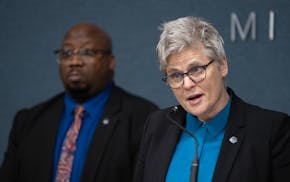Minnesota's projected budget surplus now stands at $9.25 billion, and the fight over how to divide that pie at the Legislature is going to be epic.
In a supplemental budget released last week, Gov. Tim Walz laid out a proposal that would send $2 billion directly to taxpayers: $500 to single filers and $1,000 to joint filers. If passed by the Legislature, those checks could go out as early as this summer to some 2.7 million Minnesotans, Walz told an editorial writer.
Other priorities that the Star Tribune Editorial Board has supported strongly are the complete replenishment of the Unemployment Insurance Trust Fund (UI), $2.7 billion; plus about $1 billion in bonuses to an expanded pool of frontline workers who did not have the safety of working remotely during the pandemic.
Walz' overall budget proposal also devotes $300 million over three years to local communities for public safety needs, including police recruitment, funds to improve 911 dispatch systems, body cameras or whatever local priorities demand. The average city would receive about $240,000 in aid.
There's more, but these are all vital areas deserving of funds.
Republicans, however, see the state surplus — one of the nation's largest — as an opportunity to offer permanent income tax cuts and a complete exemption from taxation for Social Security income. Cutting taxes at the bottom level, as Senate Republicans are proposing, would benefit all workers but could put this state's finances in jeopardy in coming years.
The income tax cut would shrink the state's first-tier bracket from 5.35% to 2.8%. They have estimated that would save joint filers making a combined $100,000 about $1,000. A filer making $37,000 would save about $500 a year, or a little less than $10 a week.
The difference is that those cuts would go on year after year, whether the state could afford them or not.
Those permanent cuts must be weighed against a still uneven pandemic recovery made more tenuous by inflation that is now running at about 8% — the highest in 40 years — and a war in Ukraine that could be the harbinger of a wider conflict. The prospects for another recession have sharpened.
It wasn't too long ago that this state was mired in projected deficits that stretched on for years until taxes were raised in 2013. Great care must be exercised when cutting rates. The state has a responsibility not to knowingly overtax, yes, but it also has a responsibility to ensure continuity in vital services, such as health care and education, which make up a large majority of what the state spends its money on. Cuts there have direct impact on the most vulnerable Minnesotans.
And consider this: Melissa Lam Young, assistant commissioner at Minnesota Management and Budget, confirmed to an editorial writer that $4.1 billion, nearly half the total projected surplus, is non-recurring.
Like Walz, Senate Republicans also support full restoration of the unemployment fund, but they would limit frontline worker bonuses to $250 million, citing an agreement reached last year when, it must be noted, the projected surplus was nowhere near as large as it is today.
That's simply not justifiable when they propose holding businesses — including some large corporations that did quite well during the pandemic — harmless from any increases in UI fees. Similarly, the DFL-controlled House would arbitrarily limit UI funds to a little over $1 billion — equal to the amount given to frontline workers. That seems a forced bit of equality that could needlessly hurt smaller and mid-size businesses, along with their workers.
The arguments over permanent vs. one-time tax relief and spending are perennial. They will not be settled by this Legislature any more than by previous ones.
It would be far more sensible instead to use the remaining months of the session to focus on common ground — and there is a lot of it. Tax relief in this time of rising energy and food costs would be welcome. How about one-time checks and a more modest permanent tax cut? Slashing the first tier to 2.8% would take $8.5 billion out of state coffers in just three years. That's a massive commitment that would rob the state of its ability to address other critical issues, like public safety.
And there is much to do on that front, all of which costs money. Some 9,000 officers across the state lack body cameras. Walz said he has spent months talking to mayors, police, firefighters and activists across the state. "There is no one-size-fits-all," he told an editorial writer. "Brooklyn Park needs money for officers. Eagan wants to do more with mental health units. Duluth police need new equipment. St. Louis Park wants to direct all its police calls to 911, so it can sort what needs an officer, what needs a mental health response. That's an experiment that deserves funding." Republicans want to embark on recruitment and retention proposals that could bolster law enforcement across the state.
Picture this: Minnesota ends its legislative session in May with rebate checks and a small permanent tax cut, money to improve public safety in every part of the state, protection for businesses against costly UI increases, and a fulfillment of the long-delayed promise to reward frontline workers for their efforts during the pandemic.
That is a result of which we all could be proud.

BWCA's future likely hinges on election
Saving the dinosaurs: Why there's a future for community newspapers
Readers Write: Gun storage laws, Uber and Lyft, 24/7 businesses, the pipe organ


